How to Motivate Your Best Employees

Working out how to motivate your best employees can be quite intimidating and challenging as a manager. Your best employees, when motivated and focused, make an outsized contribution to what the team produces or the team’s results.
A study published in Personnel Psychology involving over 600,000 data points showed the top 5% of performers produced 26% of the company’s output, or 400% more than average while being paid around 20% more than average. Other studies return similar results. The more complex the job, the bigger the impact on the company’s performance the top performers have – over average performers.
Motivated employees contribute more. How to motivate your best employees to get more from them and to keep them for longer makes a massive difference to the team, the company and you, the manager.
5 Factors To Motivate All Employees
- Trust and Respect Your Employees
- Treat Everyone Fairly and Equally
- Spend Time Listening to Your Employees
- Focus on Removing Problems
- Be There For Your Employees
Motivating employees, whatever their skill level, requires the manager to know their staff and understand what the gap is between the employees’ current situation and their aspirations and how the manager can help bridge that gap. Every person is different – there is not as one approach fits all.
Through their behaviours, decisions and actions, leaders and managers have a huge impact on team motivation and influence the culture of the organisation or how colleagues treat each other. The biggest impact in motivating employees and ensuring they are happy is how they are treated by their leaders AND their colleagues.
Watch on YouTube
Listen on Podcast
Here are 5 factors to motivate all employees
There are a lot of factors that go into motivating employees and getting more from team members. Every employee prioritises differently the factors that motivate them as an individual. In my experience these 5 factors are on everyone’s list of what motivates them.
Employees want to the trusted and respected.
Trust is allowing employees to make decisions in their areas of expertise, it is listening to their ideas and acting on them, it is giving them true responsibility and autonomy. Trust is displayed through your decisions, actions, and policies rather than the words said.
Secondly, employees want to be treated fairly and equally.
Some examples of fairness include ensuring the same rules apply equally to all, the same pay for the same role and performance, the same access to benefits, training opportunities, job flexibility and so on. The manager needs to be disciplined to apply consistency of behaviour, decisions and actions to each employee in their team. Managers need to be seen as being consistent too.

The third way to motivate is spend time listening to employees.
This is more than just actively listening. To manage well you must connect with all types of people, get to know them and keep their interests and ambitions in mind when delegating work and making decisions. Listening includes really considering employee ideas and suggestions and acting on the good ones. Focus on finding the best ideas regardless of where they come from. Listening is also about being open to changing your mind because of what they tell you.
Fourth, spend part of each week focused on removing problems
– team members or the whole team – are experiencing. Everyone loves a manager that cares enough to take action to remove pointless processes or tasks and activities that are distracting in reaching team goals or poorly performing staff or disruptive staff – anything that makes getting the best from team members harder.
The fifth way to motivate employees to be there for them.
Demonstrate you have their back through supporting them when they need help, or fighting their corner so they get the resources they need, or protecting the team from company politics and changing priorities. Demonstrate that you are loyal to your team and are working to make their lives at work easier and better.
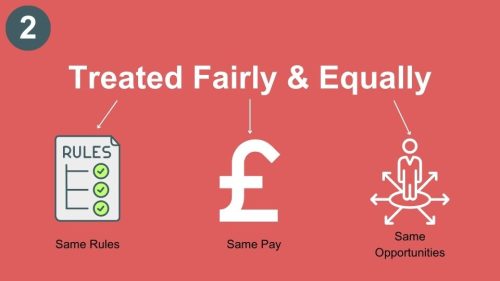
Now let’s cover:
How to Motivate Your Best Employees
As mentioned previously, find out what your employees want, what their professional interests and ambitions are and how you can best help them on their path to achieving those ambitions.
The first way to motivate your best employees is to
provide a tailored development plan
or career plan and proactively and visibly work to deliver the development opportunities you have committed to. They know you are working to further their career. This is a great way of keeping your best employees.
The second way to motivate high performers is to
highlight what they are going to learn
with each task, activity, or project you give them. This takes a little bit of thought and effort on your part. Spelling out how they are going to improve reminds your best employees how you are helping them.
The third way to motivate your best employees is to
delegate problems not tasks
The better team members usually want and need challenge and to feel they are using and improving their skills. Delegating problems help your best employees practice leadership, problems solving, decision making, organising, negotiating, and a host of other skills. Just delegating tasks, with all the solution phases already done, deprives the best team members of challenge and development opportunity which is very demotivational.

The fourth way to motivate your best employees is focus on giving them responsibility and autonomy
Practically, this is making sure you stay out of their way, that you don’t make decisions for them, that you provide support through coaching rather than telling. Publicly, it is giving the better performers authority and the resources to deliver to goals without needing additional permission and input from you.
The fifth action to motivate your best performers is
demonstrating that they are valued
There are so many ways to do this –
- publicly praise them,
- give them fun rewards like time off or meals with their partners,
- ask them to teach other team members,
- ask them to challenge solutions and listen carefully,
- ask for their opinions and suggestions,
- ask them to lead problem solving groups.
Think of all the ways you can demonstrate through your actions and decisions that you value your best employees.
The sixth way to motivate your best employees is
making the time to provide really useful feedback
The better performers want and need feedback so they can carry on improving what they do. Don’t give them bland unhelpful feedback. Make your feedback well thought out and very specific. Explain well thought through reasons for the feedback and include the impacts of what they have done. Don’t forget to challenge them to come up with better options for use next time.
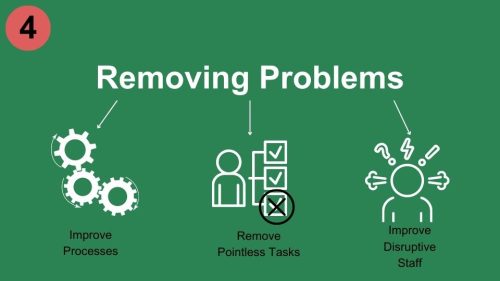
The seventh way to motivate your best employees is to
help them raise their profile
with more senior management layers within the organisation. A higher profile within management circles tends to lead to more and better development opportunities; help, advice and feedback from a wider range of people and a higher chance of promotion sooner. All of these are very motivational for high performers.
The eighth way in how to motivate your best team members is to make sure their
pay raises and bonuses are higher
than those of averagely performing employees. Move away from binary bonus schemes for your best performers – where they either pass or don’t their goals. Create a ladder of increasing bonus levels for corresponding rising goals instead. Focus the pay differential more on bonuses rather than salary levels as this is less likely to demotivate averagely performing staff members.
Use these behaviours and actions in getting the best from team members. How to retain your best employees must include consistently rewarding great performance. Motivating and keeping your best employees makes a huge different to your team performance and your job as a manager.
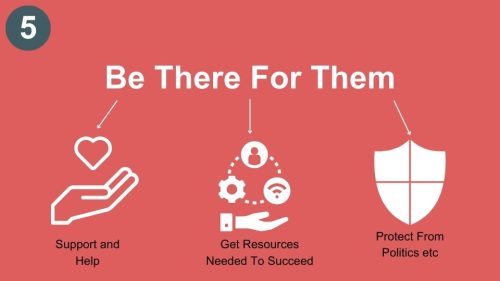
Tips to avoid motivating one group while demotivating other groups
As a manager and leader, you are always undertaking a careful balancing act. Focusing too much on developing and rewarding your best employees can create resentment and de-motivate all your other employees. This is as bad as treating your best employees in the same way as your worst employees.
I would suggest creating opportunities for all team members to grow, learn, progress and be rewarded. Give everyone the opportunity and access to get better rewards and opportunities but tie them carefully and consistently to how each person performs. When you are open and consistent about how you develop and reward staff in exchange for different levels of performance, then it is the employee’s choice as to where they want to be on the scale. I have found this reduces the risk of creating unfairness, tensions, and resentment. Be open, fair and consistent with opportunity and reward.
In summary
Creating the environment to motivate team members to do their best work is a key part of a manager’s job. Learning how to motivate your best employees will help you get the best from them while keeping your best employees for longer. This is very much in your interests as well as your team and company’s interest. The best employees deliver more than 400% more than an average employee per studies. This is a big difference in performance for an average of 20% more pay.
We have covered
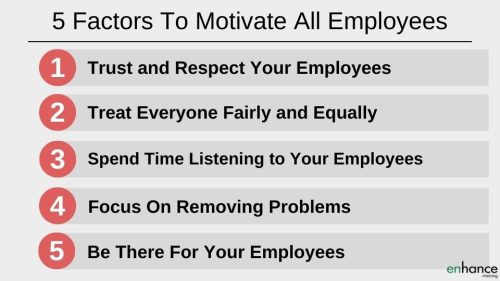
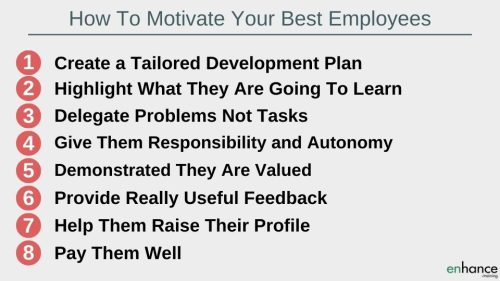
plus at the end tips on how to avoid motivating one group while demotivating other groups.
Think of different ways to motivate your best employees. All teams need their best performers to be motivated, engaged and planning to stay with the team.
If the best performers are learning and making progress towards their personal and career goals, you have a better chance of keeping them for longer and getting more out of them.
Please put as many of these suggestion into practice as you can. You, your manager and your team will be a lot happier because of your efforts.





